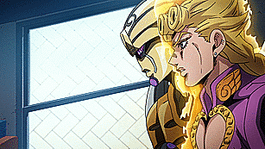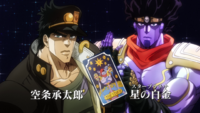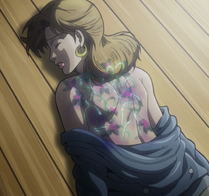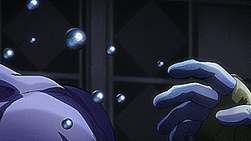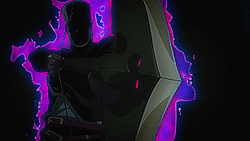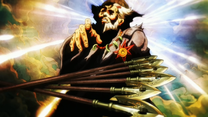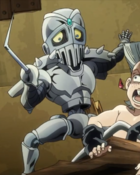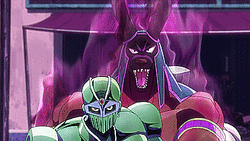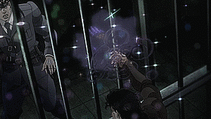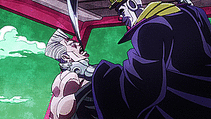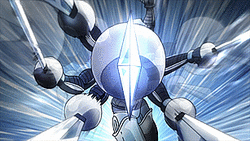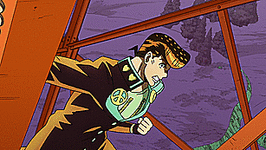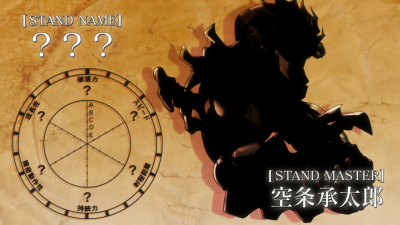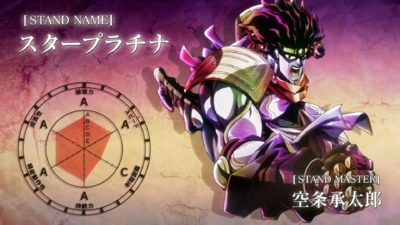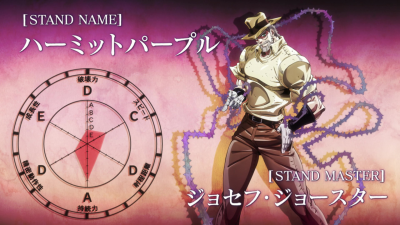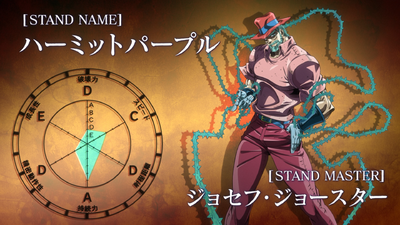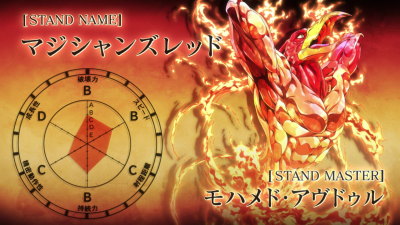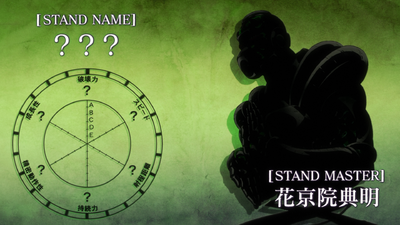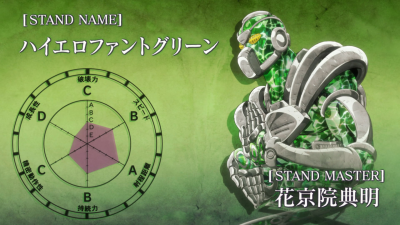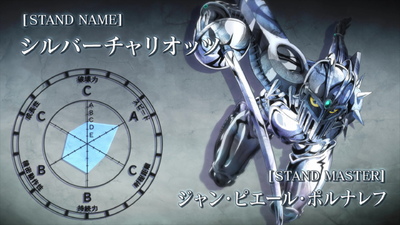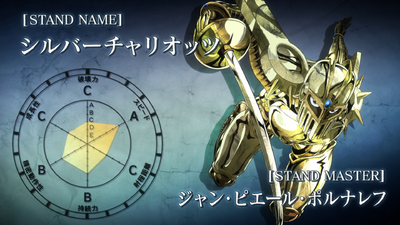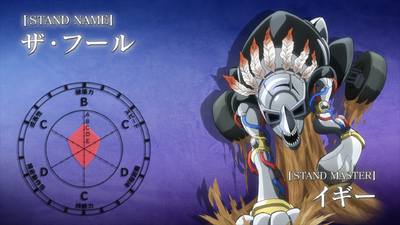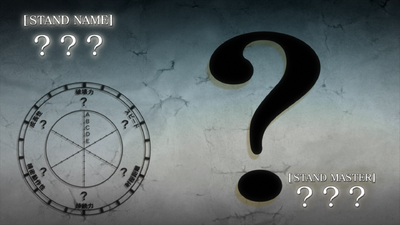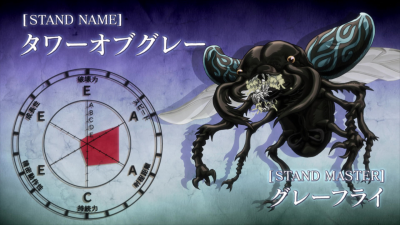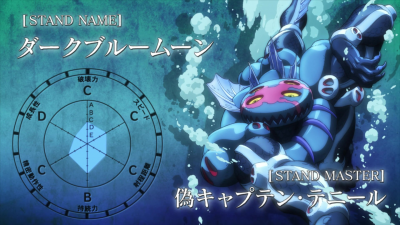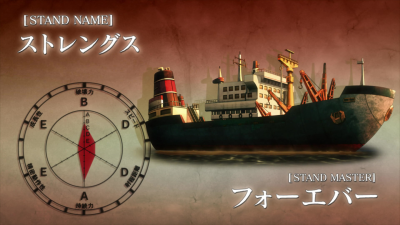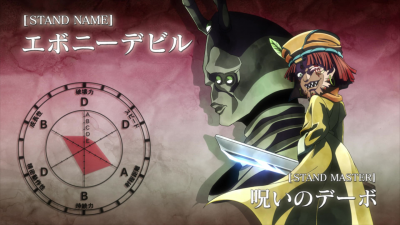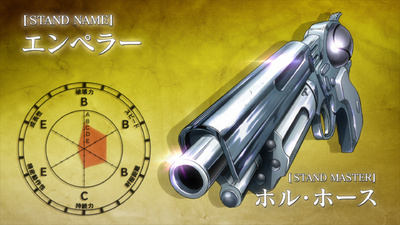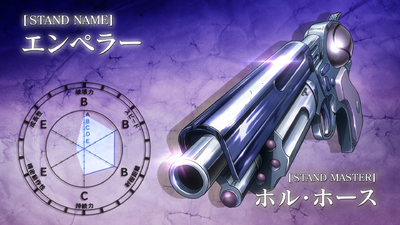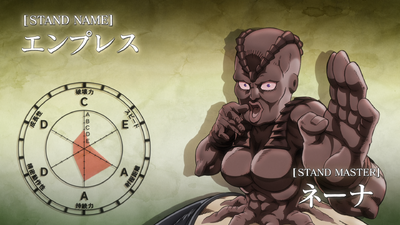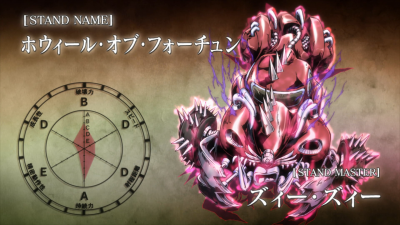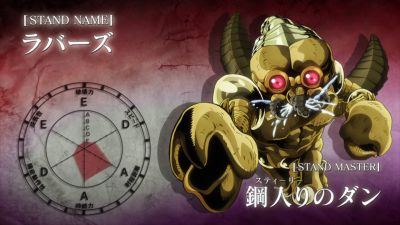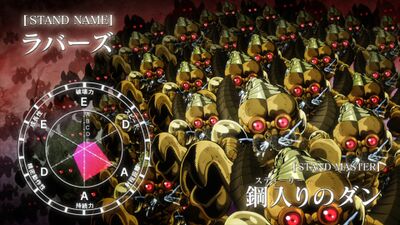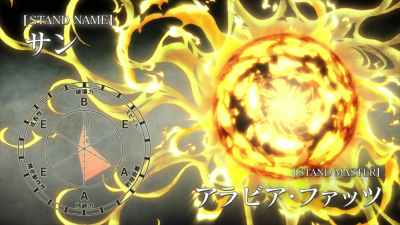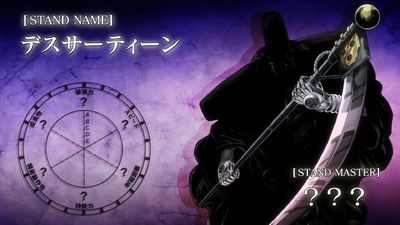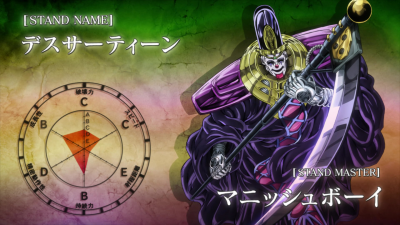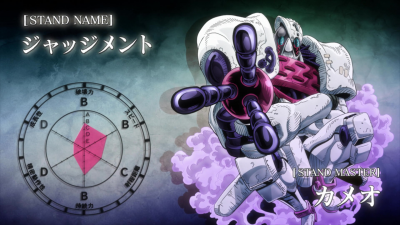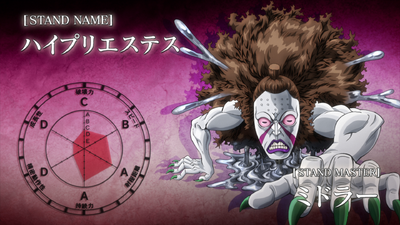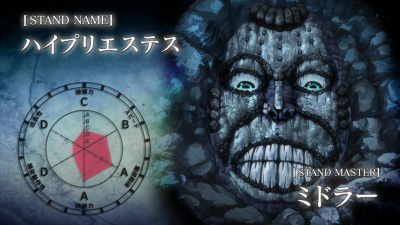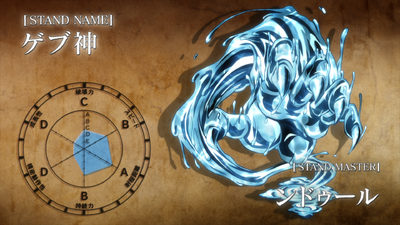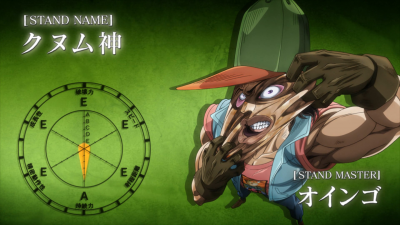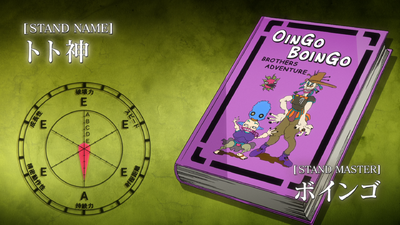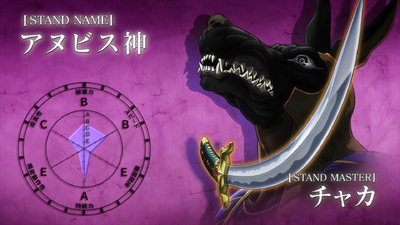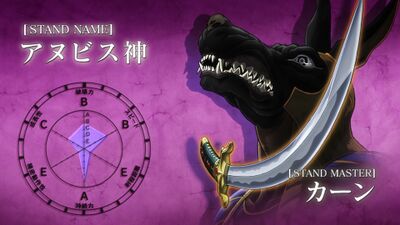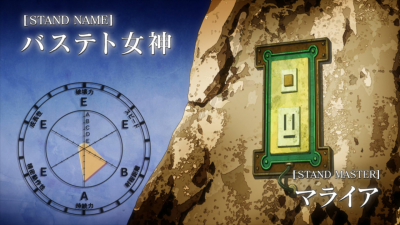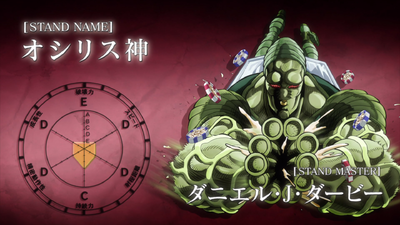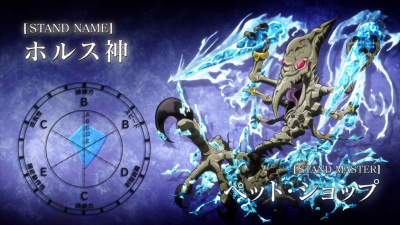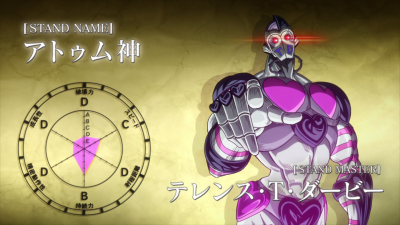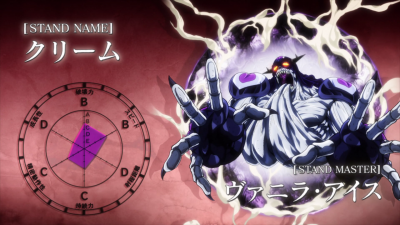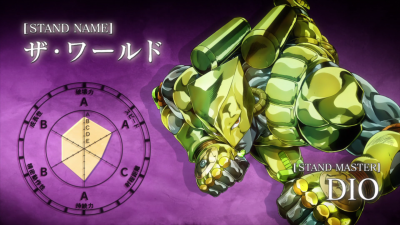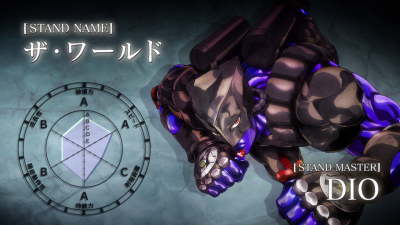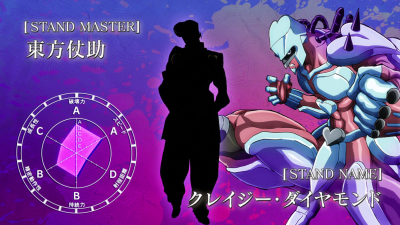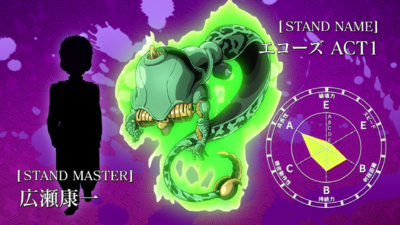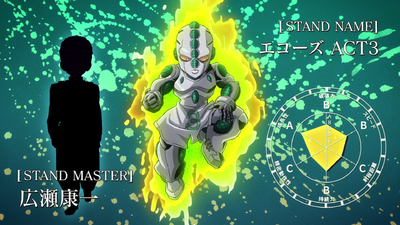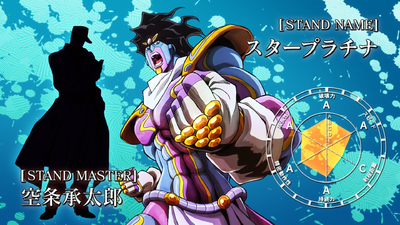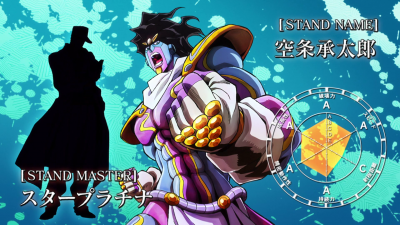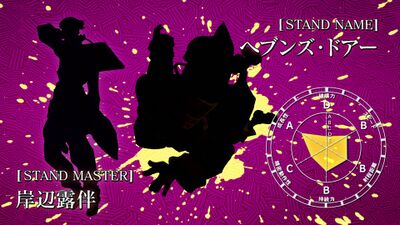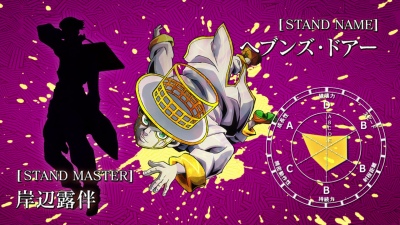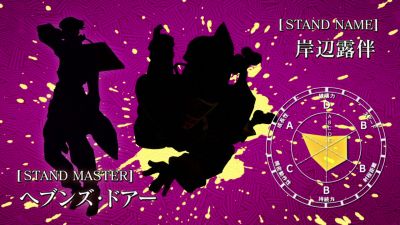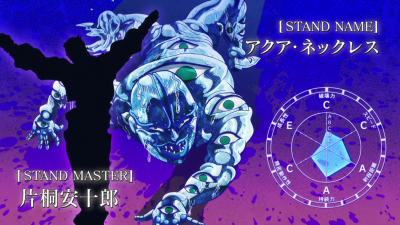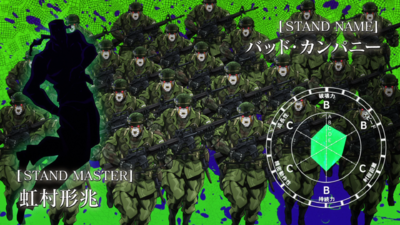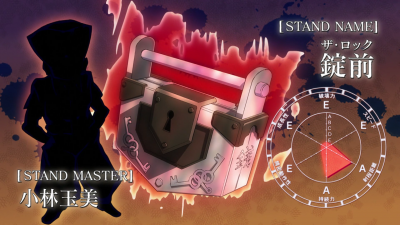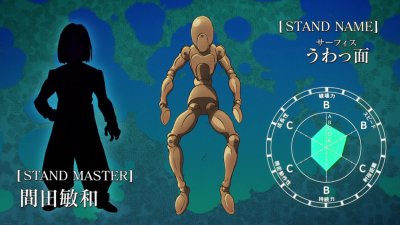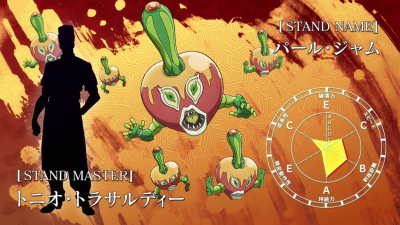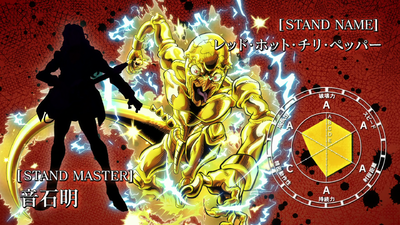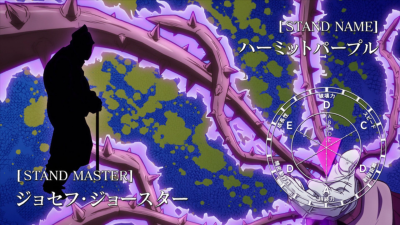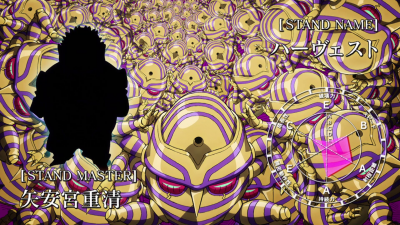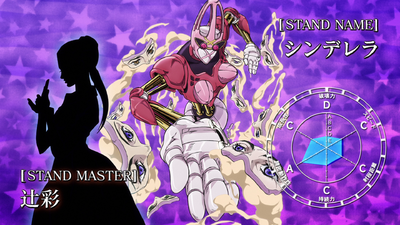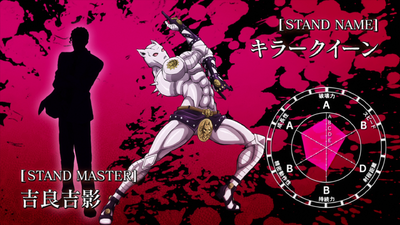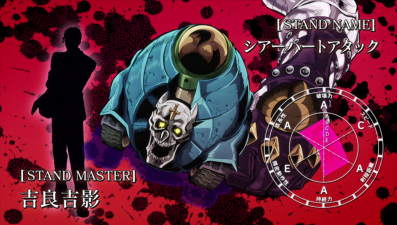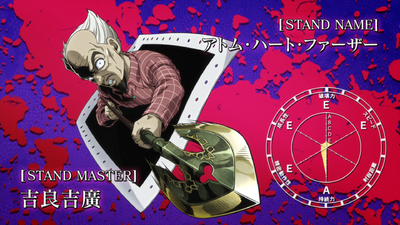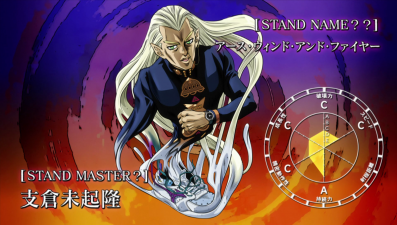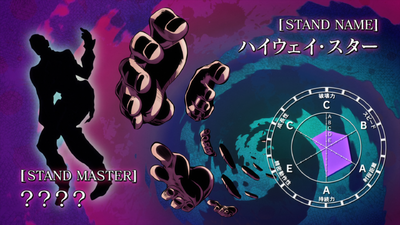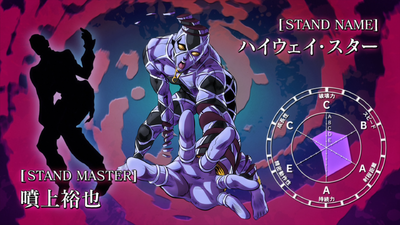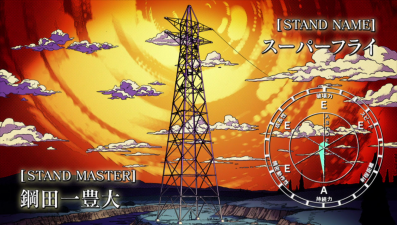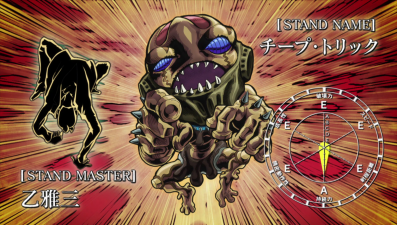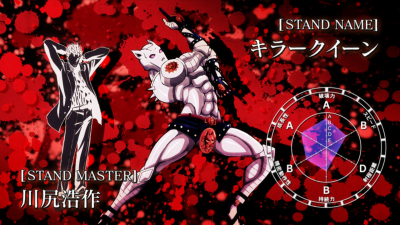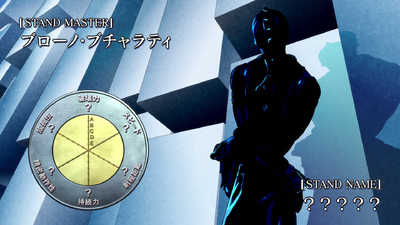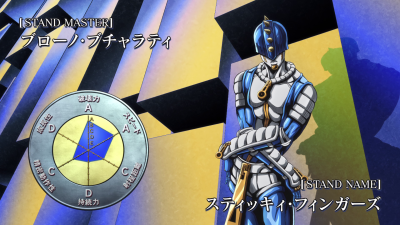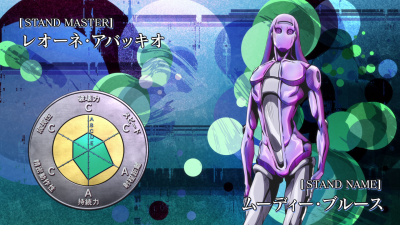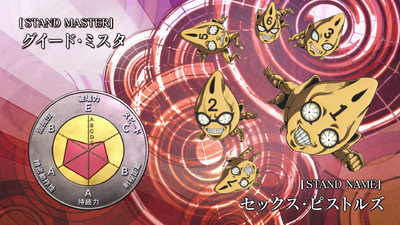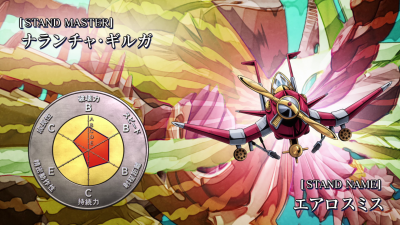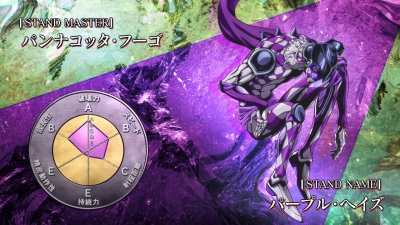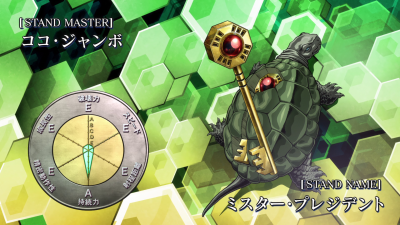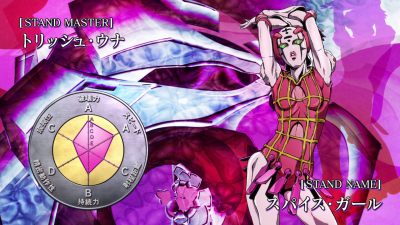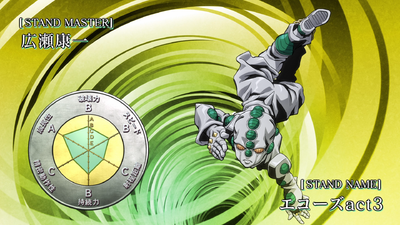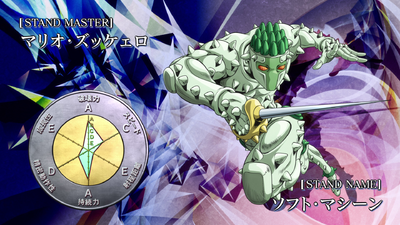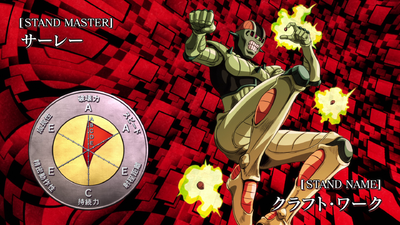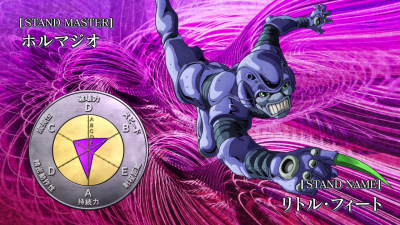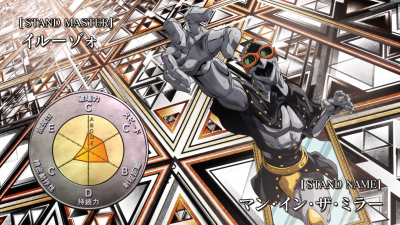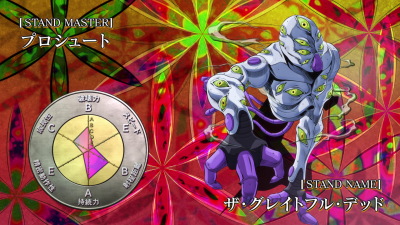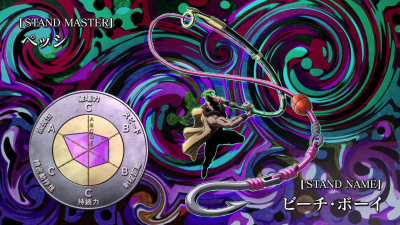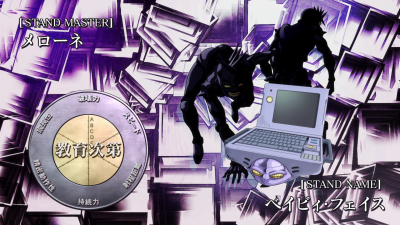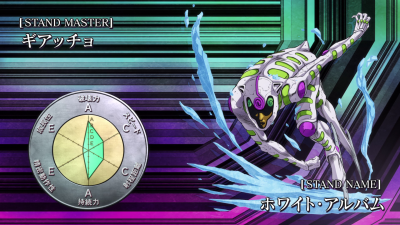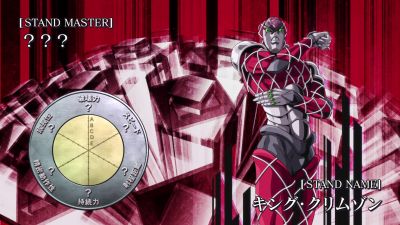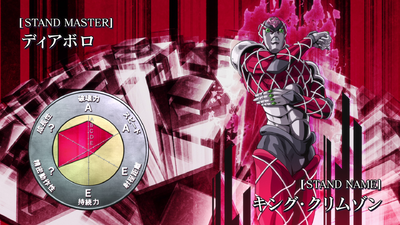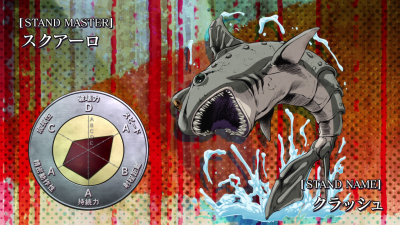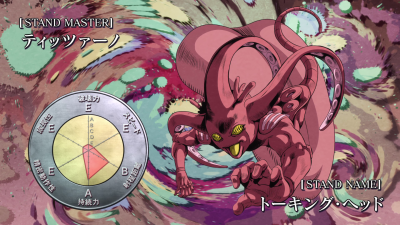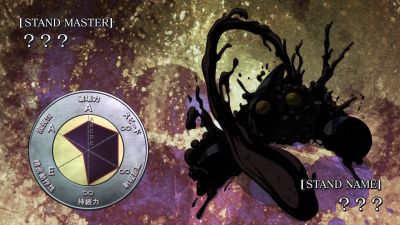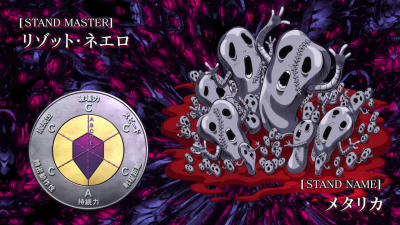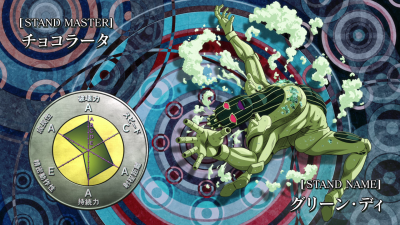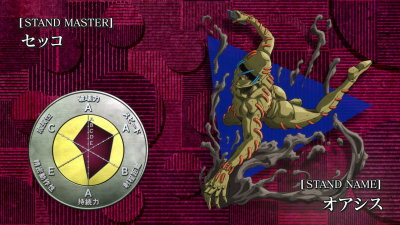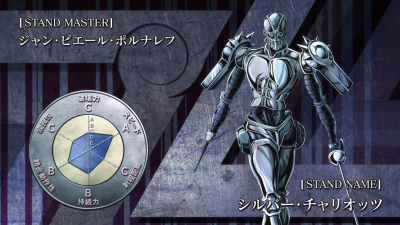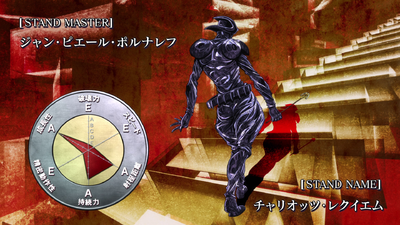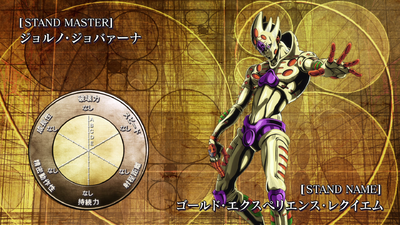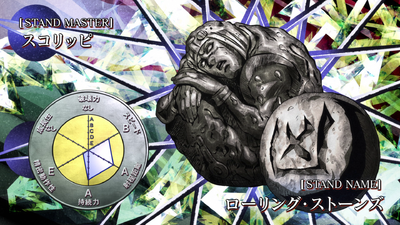Stand
Un Stand (スタンド, Sutando) es la manifestación física de la "energía vital" (生命エネルギー, Seimei enerugī) de una persona.[1] Es un poder único de la serie JoJo's Bizarre Adventure.
Un Stand es una entidad generada psíquicamente por su propietario, conocido como Usuario de Stand (スタンド使い, Sutando Tsukai).[2] Por lo general, se presenta como una figura etérea que flota o presenta sobre el usuario o cerca de él y posee habilidades más allá de las de un humano común, que, dependiendo del Usuario del Stand, se puede usar para bien o para mal.
Definición
Los stands se definen como personificaciones de "energía vital" cuyas habilidades se les da forma visual. Cuando se presenta por primera vez, el término se escribe como "Stand" (
Un Stand también puede representar la manifestación del "espíritu de lucha" innato de un individuo y encarna, hasta cierto punto, la psique del individuo. Sin embargo, los Stands también pueden derivarse de la exploración de posibilidades y la expresión de la mente, en cuyo caso, solo se requiere una gran cantidad de fuerza mental. Más allá de esa definición, los Stands se presentan en una gran variedad de formas y con diferentes comportamientos, si es que poseen conciencia. Siguen un conjunto de reglas que no todos los Stands obedecen ya que no hay un estándar definido por el cual uno pueda clasificarlos completamente. Como son la encarnación de la psique de alguien, los Stands son tan variados como lo son las mentes humanas.
Debido a su diversidad, no hay Stands iguales. Algunos pueden ser increíblemente poderosos debido a la valentía excepcional de su Usuario, otros pueden ser altamente situacionales debido a una peculiaridad definitoria del carácter, o incluso perjudiciales para su usuario si no tienen el espíritu de lucha necesario.
Cuando los Stands se introdujeron por primera vez en Stardust Crusaders, fueron nombrados como los Arcanos Mayores del Tarot y después como dioses del Antiguo Egipto, con diseños que en ocasiones se basan o tienen detalles inspirados en la temática de las cartas o deidades. Hacia el final de Stardust Crusaders y en todos los arcos narrativos posteriores, los nombres de los Stands hacen referencia a músicos, bandas, álbumes y canciones de las escenas musicales de Estados Unidos, Australia, escenas británicas y europeas; únicamente el nombre de un solo Stand hace referencia a música japonesa.[4]Los Stands también están conectados a un virus alienígena contenido en la roca de un meteorito que cayó en Cape York, Groenlandia. Se explica que el virus puede infectar a las personas y en su mayor parte las mata, pero a los pocos que sobreviven se les concede una habilidad Stand.[5]
El Usuario y su Stand
El Stand se crea a partir de la psique de alguien, que incluye no solo a los humanos sino también a otras criaturas vivientes. Ese individuo se conoce como el Usuario de Stand. Después, el Usuario da un nombre a su Stand y lo utiliza para diversos fines.
A menos que estén vinculados a un objeto específico o que sea automático, los Stands se adjuntan al cuerpo de su Usuario. En ese caso, cualquier daño que sufra el Stand resultará en una lesión equivalente en el cuerpo del Usuario y viceversa. Las excepciones a esta regla incluyen Stands automáticos y Stands vinculados, que generalmente no reflejan el daño en el Usuario, o habilidades especiales como la armadura de Silver Chariot.
Excepto en raras ocasiones, cuando un usuario de Stand muere, su Stand desaparece con él. Si un Stand sufre tanto daño que se destruye, el Usuario también muere. Sin embargo, un Usuario puede sobrevivir con su Stand destruido [6] si el Stand es automático o dependiendo del nivel de lesión del Usuario. Inversamente, algunos Stands pueden sobrevivir más allá de sus Usuarios a través de habilidades excepcionales como Notorious B.I.G.
Dado que un Stand es la forma de la psique de su Usuario, comparten un vínculo psíquico íntimo. En primer lugar, los Stands suelen obedecer las órdenes de sus Usuarios sin dudarlo. Si un Usuario lo exige, el Stand realizará cualquier tarea dentro de sus capacidades, que incluye atacar a alguien, defender al Usuario o cualquier orden miscelánea. En el caso de que un Stand sea consciente, ocasionalmente puede advertir a su Usuario que una orden no es prudente, pero lo hará de todos modos. Los Stand también se manifiestan para protejer a sus usuarios en ciertas circunstancias como cuando Jotaro intenta dispararse a si mismo,[7] o cuando Weather Report trata de cometer suicidio.[8]
Sin embargo, hay ocasiones en las que un Stand no puede ser controlado por el usuario. Puede deberse a que es un Stand automático como Super Fly o el usuario no tiene un espiritu de lucha para poder controlarlo como Holy Kujo.[9] En ambos casos, el Stand puede actuar en contra de los intereses de su usuario a través de su poder no supervisado. Sin embargo, específicamente en el segundo caso, un Stand puede salirse de control y matar lentamente a su usuario como si fuese una enfermedad. Según Muhammad Avdol, el usuario se enferma, luego cae en coma sólo para no volver a despertar jamás; además, tales sucesos son lo suficientemente comunes como para que él afirme haber presenciado a muchas personas sucumbir a esto.[9]
Una de las reglas importantes sobre los Stands es que alguien solo puede tener un Stand a la vez. Aunque los Stands pueden tomar diferentes formas o dividirse en varias entidades, nadie puede invocar varios Stands a la vez. Aunque circunstancias excepcionales pueden llevar a que alguien maneje varios Stands, solo uno será el Stand real del usuario. Generalmente un Stand permanece junto a su usuario, pero a veces puede cambiar de usuario. Por ejemplo, puede ser hurtado de su usuario original o si la habilidad del Stand implica cambiar de usuario. Gracias a los DISCs de Whitesnake, un Stand puede cambiar de usuario pero actuará para proteger a su nuevo usuario. Otros Stands como Anubis o Cheap Trick intentarán cambiar constantemente de usuario y su naturaleza maligna los hace dañar a sus usuarios en lugar de protegerlos.
Ocasionalmente, un Stand puede emitir un Grito de Batalla, gritando repetidamente mientras da una paliza.
Utilizando un Stand
Cuando un usuario adquiere su Stand, el control que tiene sobre el es en parte instintivo, pero necesita práctica.
Cuando un Usuario descubre su Stand, normalmente no sabe nada al respecto y, por tanto, tiene que averiguar cuál es su poder. A veces, la habilidad es sencilla y fácil de entender como el Echoes de Koichi Hirose, en otras ocasiones un Stand consciente puede explicar el poder directamente a su Usuario como lo hizo Spice Girl para Trish Una,[10] pero a veces el Usuario necesitará tiempo para conocer el poder de su Stand. Por ejemplo, tanto DIO como Jotaro poseyeron sus Stands durante algún tiempo hasta que descubrieron que podían detener el tiempo.[11]
Posteriormente, depende del Usuario descubrir qué puede hacer realmente su Stand con su capacidad. Un usuario de stand necesitará práctica para desarrollar el potencial de su stand y manipularlo de una manera más precisa. Las sutilezas y aplicaciones ocultas del poder del Stand pueden requerir tiempo para que el Usuario se dé cuenta. Giorno Giovanna, por ejemplo, tuvo que usar Gold Experience en Bruno Bucciarati para descubrir lo que su habilidad de dar vida ocasionaba a los humanos,[12] y de manera similar tuvo que darse cuenta de que sus habilidades podían reparar heridas.[13]
Para utilizar un Stand, el Usuario debe invocarlo conscientemente. Asimismo, para utilizar su poder, el Usuario debe comandar su Stand. Por lo tanto, los usuarios de Stand siguen siendo vulnerables a los ataques furtivos. Esto no se aplica a los Stands automáticos que actúan por sí mismos.
Obteniendo un Stand
- See also: Bow and Arrow and Devil's Palm
Stands are also noted to awaken through the mere presence of powerful Stand user in the general area,[15] however the most widespread way to trigger one immediately is to be pierced by a special Arrow made from a meteor from outer space. If a person has the potential, they will survive being stabbed and acquire a Stand. Otherwise, the person will die. Notable people who unlock their Stand this way include DIO, Koichi Hirose, Diavolo, Enrico Pucci, and Jolyne Cujoh.
Además, si alguien adquiere un Stand de esta manera, sus descendientes existentes también obtendrán un Stand, aunque es posible que no se manifieste al principio o sea incontrolable. En uno de esos casos, el cuerpo de Jonathan Joestar fue perforado por la Flecha, lo que provocó que cada miembro vivo de la Familia Joestar despertara sus propios Stands. La forma en que los hermanos adquieren Stands se describe de manera inconsistente: aunque Koichi Hirose despertó un Stand, su hermana Ayana Hirose no lo hizo; sin embargo, los gemelos Enrico y Weather despertaron un Stand cuando Pucci fue perforado. Si una persona sin hijos adquiere un Stand, sus futuros hijos tendrán al menos el potencial de desarrollar un Stand.
En la nueva continuidad de Steel Ball Run y JoJolion las Flechas no existen. Se desconoce la forma en que los usuarios de Stand más conocidos han adquirido el suyo. Sin embargo, un método confirmado para adquirir un Stand es sobrevivir pasando por un lugar llamado Devil's Palm, una parcela de tierra cambiante que contiene el Saint's Corpse que puede bendecir a alguien y darles un Stand.
Conexión Espiritual
Primeramente, los Usuarios de Stand atraen a otros Usuarios de Stand. Comparado por distintos personajes con el "hilo rojo del destino" o "gravedad", este enlace asegura que los Usuarios del Stand se encontrarán eventualmente, especialmente si viven en la misma área general. Esta regla fue la más frecuente en Diamond is Unbreakable y Vento Aureo, donde muchas reuniones fatídicas, como la de Koichi Hirose encontrándose inmediatamente a Giorno Giovanna cuando se le asignó esa tarea,[16] tenían este fenómeno como su explicación subyacente.
En segundo lugar,si los usuarios de Stand están relacionados entre sí, compartirán un fuerte vínculo psíquico. Se muestra de manera más prominente como una capacidad para sentir la presencia de Stand usando parientes. Incluso sin haberse conocido en persona, las personas que comparten este enlace podrán decir aproximadamente qué tan lejos están, aunque no pueden discernir la dirección de donde proviene la sensación. También pueden saber si sus familiares están vivos o muertos independientemente de la distancia.[17][18] Estos matices se usaron, por ejemplo, en la batalla con DIO, cuando Joseph Joestar en retirada "enmascara" la presencia de Jotaro Kujo acercándose a DIO por la espalda,[19] también fue la razón por la que el Jefe de Passione consideró que matar a su hija separada Trish Una era esencial para mantener un anonimato total.[20]
Si los lazos familiares entre los Usuarios de Stand son especialmente fuertes, como el vínculo entre gemelos o el cariño padre-hijo, las personas en cuestión a veces compartirán lesiones o incluso cambios sobrenaturales en su cuerpo.[21] Esto se mostró con Enya Geil manifestando las heridas de su hijo después de su muerte,[22] y Jotaro inconscientemente enviando un mensaje a Jolyne Cujoh mediante Star Platinum grabando su nombre en su piel.[23]
En la nueva continuidad únicamente se ha mencionado la regla de atracción entre Usuarios de Stand hasta el momento.[24]
Historia de los Stands
- See also: Bow and Arrow and Saint's Corpse
Los "Stands" en JoJo se pueden conceptualizar como una reificación de talento oculto, siendo su fuente una especie de energía que ha estado en la Tierra desde la antigüedad.[25] El ejemplo más antiguo de un Usuario de Stand se remonta al siglo XVI con la muerte de Caravan Serai y la emancipación de su Stand, Anubis.
Aproximadamente hace 50.000 años, un meteorito se estrelló en la Tierra alrededor de una región poco poblada de Cabo York, Groenlandia. Varios cientos de años antes del descubrimiento del virus, un hombre que deseaba adquirir el poder de los dioses tomó las rocas y las transformó en un conjunto de Flechas cuyo destino es desconocido.
En 1978, un equipo de excavación de minerales descubrió el meteorito y descubrió un virus desconocido dentro de las rocas del área circundante y determinó que había estado inactivo dentro del meteorito que golpeó la Tierra hace mucho tiempo. A pesar de una extensa investigación, los médicos del gobierno no pudieron determinar el propósito del virus alienígena fuera del sacrificio de la vida. Al igual que la teoría de la evolución, se descubrió que ciertas personas poseían una cualidad que les permitiría sobrevivir cuando se exponían al virus, recompensándolas con nuevas habilidades a medida que superaban la prueba.[26]
Las Flechas resurgieron en 1986 cuando un equipo de investigación de ruinas egipcias descubrió seis de ellas debajo del desierto de Egipto. Las Flechas fueron finalmente robadas por Diavolo, quien vendió cinco de ellas a Enya the Hag. Las flechas permitieron al portador desbloquear las habilidades de Stand en aquellos que tenían el potencial de despertar uno, esencialmente actuando como el desencadenador mencionado anteriormente. Así, desde los años 80 se ha producido un fuerte aumento de la población de usuarios de Stand. Las seis flechas se distribuyeron finalmente a varias personas, entre ellas Keicho Nijimura, Yoshihiro Kira, Jean Pierre Polnareff y la Fundación Speedwagon.[27]
Segunda Continuidad
En partes posteriores, los Stands fueron reintroducidos pero ahora con un origen real desconocido. En Steel Ball Run, se describió que los Stands fueron otorgados por la Palma del Diablo y el Cadáver Santo que otorgaron poder a aquellos que podían buscarlos y sobrevivir a su presencia. Sin embargo, varios usuarios de Stand adquirieron sus poderes sin siquiera pisar Estados Unidos o reunirse con el Cadáver, sobre todo los personajes de JoJolion.
Apariencia
Los Stands se presentan en una amplia variedad de formas. Algunos adoptan una forma humanoide, otro, la apariencia de un objeto o una herramienta. Todos estos Stands comparten la incapacidad de ser vistos por humanos comunes, a menos que estén vinculados a objetos físicos. Además, algunos Stands simplemente pueden carecer de apariencia, simplemente manifestándose como un poder especial.
Los stands se pueden dividir en 5 categorías en función de su apariencia. La mayoría de los Stands tienen características de dos o más categorías.[28]
| Clasificación | Resumen |
| Humanoide Natural | Los stands de esta categoría tienen características físicas similares a las de los seres humanos, la mayoría de las veces son características de sus mismos usuarios. Las características identificables obvias incluyen brazos y piernas, pero la categoría especifica claramente apéndices que recuerdan al sistema muscular humano, además de tener ojos y boca que funcionan. Algunos Stands que aplican en esta categoría son Star Platinum, Magician's Red, Hanged Man, The World, Crazy Diamond, Heaven's Door, Killer Queen, Gold Experience, Sticky Fingers, Purple Haze, Baby Face, Spice Girl, y Chariot Requiem. |
| Humanoide Artificial | Si bien también tienen cuerpos de tipo humanoide, los Stands en esta categoría a menudo presentarán matices artificiales o mecánicos que los separan de los humanoides naturales. Esto incluye tener rasgos faciales y articulaciones mecánicas completamente no humanoides. Las apariencias que se asemejan a robots, cyborgs o androides son aplicables aquí. Ejemplos de Stands de este tipo son Hierophant Green, Silver Chariot, Ebony Devil, Death Thirteen, Osiris, Cream, The Hand, Bad Company, Cinderella, Echoes, Black Sabbath, Moody Blues, White Album, y Green Day. |
| No Humanoide Natural | Esta categoría presenta Stands que, aunque no son de apariencia humana, recuerdan a otras formas de vida u objetos de la naturaleza. Esto incluye organismos básicos como animales y plantas, pero también conceptos menos ortodoxos como la niebla. Los Stands que pueden describirse como "parecidos a monstruos" suelen ser aplicables aquí. Stands en esta categoría incluyen a Hermit Purple, Tower of Gray, Yellow Temperance, Lovers, Justice, Sun, Horus, Stray Cat, Sex Pistols, The Grateful Dead, Notorious B.I.G, Metallica, y Rolling Stones. |
| No Humanoide Artificial | En esta categoría se incluyen Stands comparables a instrumentos u objetos mecánicos. Esto incluye vehículos, armas y máquinas como lo son Strength, Emperor, Wheel of Fortune, The Fool, Ratt, Aerosmith, y Beach Boy. |
| Fenómeno | Los stands en esta categoría generalmente no tienen una apariencia clara o están integrados en la apariencia de sus usuarios. Esto incluye stands como Khnum, Tenore Sax, Love Deluxe, Achtung Baby, y Atom Heart Father. |
La apariencia de un Stand no está definida de manera permanente. Los Stands cambian a medida que sus Usuarios crecen o envejecen. Se ha visto con Silver Chariot de Jean Pierre Polnareff[29] o Speed King de Jobin Higashikata[30] que los Usuarios de Stand que son jóvenes usualmente tienen Stands con apariencia infantil y cuando se vuelven adultos, las características de los Stands también se vuelven adultas. Una categoría especial de Stands que puede evolucionar en diferentes formas o Acts, también puede cambiar de forma y por lo tanto de apariencia. Finalmente, un Stand que sea atravesado por el Arco y la Flecha puede evolucionar a una nueva forma llamada Stand Requiem.
Cuando un Stand es herido, pueden sangrar como un ser orgánico, desmoronarse en cenizas, desvanecerse en destellos de luz o romperse en pequeños pedazos como una estatua.
Comportamiento
Most Stands display no personality, sometimes because they do not have a form with which to emote, but the majority of humanoid Stands simply hover behind and above the user awaiting a command. Some Stands display bits of personalities through facial expressions, but it is ambiguous whether the emotions come from the Stand or simply reflect the User's state of mind.
For unknown reasons, a handful of Stands do have a separate consciousness from their Users. They are sentient and can converse with their Users whenever they are summoned. Although they display a variety of pSome Stands emote, but most don'tersonalities, most still obey their Users to the letter. Examples of such Stands include Echoes, Spice Girl, and Whitesnake. Rarely, these Stands are uncontrollable and have no true master, and instead, move from host to host and actively seek to harm their "user" with their powers. Anubis and Cheap Trick are examples of such Stands.
Whenever a Stand talks, their otherworldly nature is indicated in the original manga material as a text written with Katakana. In the case of audiovisual media such as the anime or a video game, a Stand's voice will possess a ghostly echo and mechanical tone.
Habilidades
Each Stand possesses supernatural properties as well as a special, unique power, indirectly granting its user superhuman abilities:
- In general, a Stand is invisible to normal humans, yet can interact with normal objects. It allows the user to use their Stand unnoticed by a large majority of the population. The mundane use of a Stand has been likened to a poltergeist phenomenon by normal people. Even a Stand's power is invisible for ordinary humans; for instance, normal people cannot see Magician's Red's flames but can feel its heat.[31]
- Stands are ethereal and, as a result, possess intangibility. It is uncommon but not unheard of for Stand Users to channel their Stands inside their bodies to protect themselves, using their Stand's superhuman durability to their advantage. It is even more uncommon for Stands to phase through objects, but the possibility exists.
- A Stand is invulnerable to any harm except against another Stand or if their Stand user is harmed.
- As psychic projections, Users can also communicate through their Stands. Barring rare exceptions, a Stand user typically shares their consciousness with their Stand and is able to see through its eyes. Moreover, a Stand user can also speak through their Stand, enabling a form of distant communication. However, the Stand must have a mouth or otherwise be able to speak to do so. Notable examples include Star Platinum, Death Thirteen, Highway Star and King Crimson.
- Users possess the ability to shrink their Stands to a microscopic level, but the one time it was shown, Polnareff indicated that it was difficult to manipulate the Stand at such a subtle level and that it was taxing to maintain the small size,[32] making that property impractical in most cases.
Poder
Each Stand possesses an esoteric and unique power that defines it and sets it apart from other Stands.
A Stand's power can wildly vary between Stands. The nature of the power can range from relatively mundane powers such as using a sword or controlling flames to extremely powerful ones such as the ability to manipulate the flow of time. These powers have many different subtleties, such as a limited range or a special way of manifesting themselves, that can be exploited during a fight. For instance, Sticky Fingers can create zippers on any surface, but it has to hit an object with its hand to be able to create them. It is up to the user to know how to protect themselves or use their enemy's weakness to their advantage.
The user is sometimes immune, or protected to a degree against the power of their Stand. For instance, Prosciutto can stay young despite his The Grateful Dead aging everyone around it. However, the reverse is just as widespread, as Stand Users like Pannacotta Fugo with Purple Haze's virus, and Muhammad Avdol and Magician's Red's flames are stated to be just as vulnerable.
In rare cases, Stands can have the same abilities. Usually, siblings like the D'Arby Brothers or two rats can roughly have the same power.
Barring rare exceptions, if the Stand is destroyed or the user is knocked out, the Stand's power immediately disappears and any modification to the environment due to its power is reversed.
Each Stand is unique, but many share enough characteristics that they may be grouped under specific Stand Types. Very uncommon special stands may appear in the story from time to time due to exceptional circumstances.
Alcance
One of the most important features of a Stand is its range. Stands in principle can only be used within a predetermined range centering around the Stand's owner. As such, for the sake of convenience, the range that a Stand can perform abilities is referred to as "Firing Range" (射程距離). A Stand's range and accuracy are inversely proportional; the further the Stand moves away from its firing range, the weaker and less subtle it becomes. This principle is applied to almost all Stands. Furthermore, this can be construed more specifically as an "effective firing range", as a Stand will only gradually lose effectiveness the further it deviates from its firing range, rather than just relinquish immediately.[28] The Stand's range is effectively just the range where it can optimally perform, though this can notably fluctuate depending on the emotional state of the user.[33]
From a general point of view, all Stands can be roughly divided into two types: "Short distance", and "long distance". As a trend, short-range types display great power, many of which excel at direct blows or destruction (Silver Chariot, Crazy Diamond, Sticky Fingers, etc.), and are often referred to as "Power Types". Long-range types typically have a special ability that can let them indirectly attack. (Hierophant Green, Echoes ACT1, Beach Boy, etc.)
Some long-distance types are referred to as "Automatic Pilot", in which the "power vs distance from user" principle does not apply. This is exactly what is touched upon in the third Stand theorem, in that autopilot types are typically an extension of an "effect" that results in a Stand triggering. As such, these Stands are independent of the Stand User's will and mental strength, and their power does not drop as a result. As a related note, certain Stand abilities do not have specified ranges (Earth Wind and Fire), an example being time-based powers, such as The World or King Crimson.[28]
Parámetros de Stand
- See also: Stand Stats
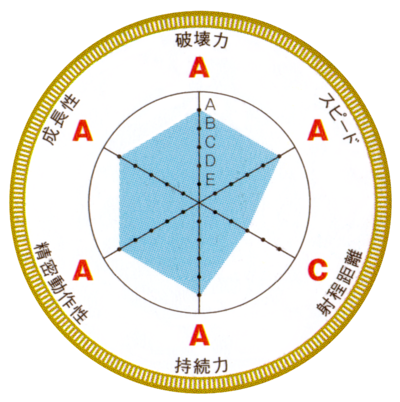
Stand Parameters (スタンドパラメータ, Sutando Paramēta), or Stand Statistics are six statistics used outside of the story to gauge a Stand's capabilities. Some parameters refer to specific abilities of the Stand, such as in the case of Moody Blues and Whitesnake. They are in order (clockwise from top): Destructive Power, Speed, Range, Stamina, Precision, and Developmental Potential.
- Destructive Power (破壊力, Hakairyoku):
Measures the Stand's strength and ability to cause destruction (physical injury or collateral environmental damage) in a given period of time. Close-Range Stands such as Star Platinum, The World, Crazy Diamond, Killer Queen, Gold Experience and Stone Free will typically boast high destructive power (Rank C or higher). There are also cases like C-MOON, where destructive power is low or not applicable, despite having fairly destructive abilities.
- Speed (スピード, Supīdo):
Measures the Stand's agility and reflexes as well as performance speed. This is also typically evaluated fairly high for Close-range Stands. Sometimes it can be strengthened through training, such as with Stands like Silver Chariot.
- Range (射程距離, Shatei Kyori):
Measures a compromise of the Stand's range of manifestation, range of ability influence, and spatial mobility. In most cases it is inversely proportional to destructive power. However, there are cases where both power and range are excellent, such as Red Hot Chili Pepper and Weather Report. In addition, a Stand's range may decrease due to evolution, such as with Echoes and Made in Heaven.
- Stamina (持続力, Jizoku-ryoku):
Measures the duration of time that the Stand can actively maintain its ability. It can also be used in the sense of the time it takes before a special ability can be activated again, such as Star Platinum: The World's time stop.
- Precision (精密動作性, Seimitsu Dōsa-sei):
Measures the Stand's accuracy and range of influence/effect of their abilities to specified targets. Automatic type Stands are generally evaluated with Rank D or under with a few exceptions.
- Development Potential (成長性, Seichō-sei):
Measures the Stand's possible functions, utilization of its abilities and powers, and capacity to improve its overall capabilities. It decreases in rank as the user masters their Stand. For example, Jotaro Kujo's Star Platinum is Rank A in Developmental Potential during Stardust Crusaders, but is given Rank C during Stone Ocean, as Jotaro has had many years to hone Star Platinum's power. However, Rank C implies that all of Star Platinum's possible abilities and functions still had not been discovered or figured out by that time. For a Stand to gain an E-Ranking, it means that either their Stand user discovered all of their Stand's abilities or the Stand came with very few abilities and thus cannot grow any more than it has. Stands such as Green Day and Notorious B.I.G, with infinitely increasing abilities, will be evaluated very high in this parameter.
Each statistic is ranked from A to E; though rankings of None and Infinite are also possible. If a rank is Unknown, it will show a question mark (?); this is usually because the Stand or its full capabilities have not yet been revealed in the storyline. Rankings are defined as follows:
- A: Very Good (超スゴイ, Chō Sugoi)
- B: Good (スゴイ, Sugoi)
- C: Average (人間と同じ, Ningen to Onaji, lit. "Comparable to a Human")
- D: Poor (ニガテ, Nigate)
- E: Very Poor (超ニガテ, Chō Nigate)
They are first seen in the artbook JOJO A-GO!GO!, later in canon from Vento Aureo onward as Stands are shown with their parameters along with their name and ability description. Steel Ball Run and JoJolion do not display parameters, but Stands introduced during these arcs are given them in artbooks.
Galería
In the anime from JoJo's Bizarre Adventure: Stardust Crusaders onward, Stand parameters appear as Eyecatch illustrations displayed after commercials. In Diamond is Unbreakable, a silhouette of the Stand user is displayed as well. In JoJo's Bizarre Adventure: Golden Wind, eyecatches are stylized by a spinning gold coin which transitions into the Stand and its information.
Stand Parameters are also used in weekly web radio programs like ORAORAdio and Morioh RADIO 4 GREAT to rate the hosts and guests.
Concepción
Araki had conceived his idea of Stand following a need to illustrate his character's abilities and drew inspiration from several sources. As the Vampires and therefore the Ripple which was needed to fight them, became less relevant, there was a need to innovate the way characters in the series would fight each other. Araki mentions several trains of thought which would eventually lead into the creation of the Stands.
In several instances, Araki says that he was influenced by spiritualism, the ancestor cult of the Shinto religion giving him the idea of an otherworldly being protecting someone.[34][35] Moreover, Yokai legends and folklore would become one of the main inspirations for the Stands' appearances.[36] Araki also claimed that the concept of Stands were inspired by the 'guardian spirit' from Jiro Tsunoda's Ushiro no Hyakutarō manga.[37]
Alternatively, starting from the idea of psychic powers, Araki mentions that his natural skepticism about psychic powers inspired him to draw a psychic entity summoned by the characters. His interrogation about how psychic powers could affect the physical world without any medium led him into illustrating the psychic powers through Stands, which could make the reader visualize the way characters affected the world with their minds.[36] Araki mentions having in mind a punching fist coming out of the body to break an object, and thought that anything could be drawn, giving him a lot of artistic liberty.[38]
Trivia
- Araki explicó que los Stands usualmente son el primer elemento que piensa cuando hace un personaje, and que luego hace el personalidad del personaje and apariencia based con el harmonía con dicho poder Stand.[36][39]
- Deste Partes 3 a 6, el nombre de cada Stand de el personaje principal se refiere a el título del Parte. (e.g. Star Platinum, Stand de Jotaro Kujo deste Stardust Crusaders).
- Al igual que los personajes con nombres de actos musicales, los nombres de Stands con nombres de músicos, álbumes o similares han sido históricamente objeto de cambio de nombre en la localización en inglés del material de JoJo, para evitar la infracción de marca registrada. Estos nombres alterados se han convertido en un punto común de disgusto y humor entre los fanáticos de JoJo's Bizarre Adventure dentro de la anglosfera, más notablemente el cambio de nombre de Dirty Deeds Done Dirt Cheap a "Filthy Acts at a Reasonable Price".
- Actualmente, los Stands que no tienen una versión anime de sus parámetros de Stand son Tenore Sax, Love Deluxe, Echoes (ACT2), Achtung Baby, Ratt y Boy II Man.
Referencias
- ↑ JOJOVELLER: STANDS | Definition of a Stand, p.316
- ↑ Chapter 139, Yellow Temperance Part 4
- ↑ Chapter 116: Jotaro Kujo (3), pg. 7
- ↑ JOJOVELLER: STANDS - Comments by Hirohiko Araki
- ↑ Chapter 552: Pronto! On the Phone, Part 2
- ↑ Capítulo 126, Silver Chariot Part 3
- ↑ Chapter 114, Jotaro Kujo Part 1
- ↑ SO Chapter 129, Heavy Weather Part 5
- ↑ 9.0 9.1 Chapter 121, The Power called a "Stand"
- ↑ Chapter 538, Notorious B.I.G. Part 6
- ↑ Chapter 257, DIO's World, Part 11
- ↑ Chapter 445, Bucciarati's Coming Part 3
- ↑ Chapter 504, Baby Face Part 5
- ↑ JOJOVELLER: STANDS | Techniques to Stands, p.319
- ↑ Weekly Shonen Jump, #13, 1997 - Chapter 496: The Grateful Dead, Part 9
- ↑ Chapter 440, Gold Experience, Part 1
- ↑ Chapter 540, Spice Girl, Part 2
- ↑ SO Chapter 20, Prisoner of Love
- ↑ Chapter 250, DIO's World, Part 4
- ↑ Chapter 520, The Mystery of King Crimson, Part 3
- ↑ Stone Ocean Capítulo 103: 3 Hombres Llevados al Hospital
- ↑ Chapter 147, Empress, Part 2
- ↑ SO Chapter 75, Father: Jotaro Kujo, Daughter: Jolyne Cujoh
- ↑ JJL Chapter 51, Vitamin C and Killer Queen, Part 2
- ↑ Hirohiko Araki, 2006
- ↑ Chapter 552: Pronto! On the Phone (2) p.13
- ↑ Chapter 569: A Brief Flashback p.13
- ↑ 28.0 28.1 28.2 JOJO A-GO!GO!: STANDS - Standlogy, pp. 84, 103-105, 118-120
- ↑ Chapter 206, "God Sethan" Alessi Part 2
- ↑ JJL Chapter 64, The Plant Appraiser Part 1
- ↑ Chapter 115, Jotaro Kujo Part 2
- ↑ Chapter 163: Lovers, Part 4
- ↑ Crazy Diamond - Vol.12 "Shueisha Jump Remix Diamond is Unbreakable Edition" P94 What is the STAND?
- ↑ Interview Archive, Animeland (06/01/2003)
- ↑ Interview Archive, French Reportage 09/20/06
- ↑ 36.0 36.1 36.2 Interview Archive, JOJO 6251
- ↑ Weekly Shonen Brackets 100Q (04/05/2003)
- ↑ Interview Archive, JOJO PS2
- ↑ Manga in Theory and Practice; Chapter 3: Designing Characters; Special Abilities and Finishing Moves, the origins of Stands.
